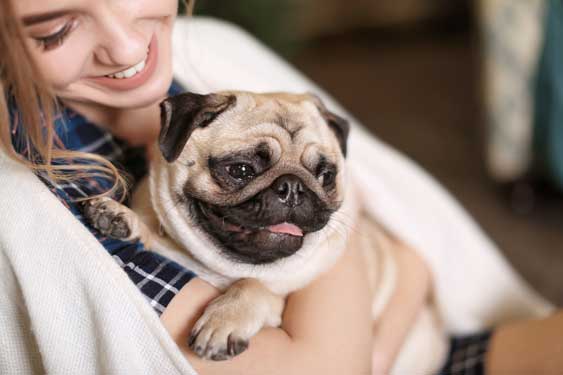The Importance of Blood Glucose Curves at Home
Performing blood glucose curves at home improves accuracy of results, allows for convenience and cost benefits, and improves monitoring capabilities. The benefits of these factors can result in a healthier pet due to better control of diabetes.
“Blood glucose curves performed at home are more accurate as the home setting allows the pet to continue its normal routine in a stress -free environment.”
Improved Accuracy of Results
Blood glucose curves performed at home are more accurate as the home setting allows the pet to continue its normal routine in a stress-free environment.
- When a pet stays in hospital, the normal routine is disrupted which often causes stress. The cortisol hormone released in response to stress impacts insulin responsiveness, resulting in falsely increased blood glucose. This “stress hyperglycemia” results in an inaccurate blood glucose curve.1,2
- Ideally, a blood glucose curve should start with a blood glucose reading right before the first morning meal and insulin administration. Often, if pets are stressed in hospital, they will not eat their usual meal amount or even at all. Again, resulting in an inaccurate blood glucose curve.1
Convenience and Cost Benefits
Owners able to perform blood glucose curves at home have both convenience and cost savings from not having to schedule as many veterinary visits.3
- Veterinary visits entail coordinating schedules, transportation to drop off and pick up pet (a full blood glucose curve takes 12-24 hours)1, and remembering to bring the pet’s food, insulin, and syringes. Because of the encumbrances, many clients do not have blood glucose curves performed as often as they should. This can result in the pet’s diabetes becoming unregulated, which comes with consequences.
- Diabetes mellitus is a disease which requires lifelong management, and therefore, expenses. The average monthly cost of diabetic care with an easily regulated pet are $50-150.4 A blood glucose curve performed by a veterinarian can cost $200 per curve.4 Performing blood glucose curves at home can save the cost of the veterinary visit for curves, but also can save on sick visits for unregulated diabetes or resultant secondary infections. For example, urinary tract infections or UTI are common in diabetic pets.5 A vet visit for a UTI will cost the exam fee, urinalysis fee, +/- urine culture fee, and cost of antibiotics.4
Improved Monitoring Capabilities
It is important to always monitor your diabetic pet closely for clinical signs of both high and low blood glucose. “The definition of a controlled diabetic is absence of clinical signs and hypoglycemia.”1
- The signs of high blood glucose include increased thirst, increased urination, and increased appetite, and weight loss.1 The signs of low blood glucose include lethargy, sleepiness, strange behavior, abnormal gait, weakness, tremors, and seizures.1
- Signs of both high and low blood glucose indicate poor regulation of diabetes. However, low blood glucose can be life threatening and requires immediate treatment.6,7
- Being able to check your pet’s blood glucose when abnormal signs are noted or after a new insulin dose has been prescribed, can provide your vet valuable insight to guide your pet’s treatment plan.2
Sources
1. 2018 AAHA Diabetes Management Guidelines for Dogs and Cats. Downloaded 7/29/2020. https://www.aaha.org/globalassets/02-guidelines/diabetes/diabetesguidelines_final.pdf
2. Audrey Cook, BVM&S, MRCVS, DACVIM (SAIM), DECVIM (CA), DABVP (Feline). Diabetes: Home Monitoring. AAFP 2014.
3. Kelly D. Mitchell, BSc, DVM, DVSc, DACVIM (SAIM). Canine and Feline Diabetes Mellitus: Owner Communication, Home Monitoring and Diet. 37TH ANNUAL OAVT CONFERENCE & TRADE SHOW.
4. Joi Sutton. It Costs What to Treat a Diabetic Pet? May 31, 2012. Downloaded 7/29/2020. https://www.adwdiabetes.com/articles/costs-what-treat-diabetic-pet
5. Rebecka S. Hess, DVM, Diplomate ACVIM, University of Pennsylvania. Part 2: Treatment Diabetes Mellitus. NAVC Clinician’s Brief November 2009. Downloaded 7/29/2020. https://files.brief.vet/migration/article/3309/diabetesmellitustreatment-3309-article.pdf
6. Hypoglycemia in Dogs. (n.d.). Retrieved September 15, 2020, from http://www.pethealthnetwork.com/dog-health/dog-diseases-conditions-a-z/hypoglycemia-dogs
7. Hypoglycemia in Cats. (n.d.). Retrieved September 15, 2020, from http://www.pethealthnetwork.com/cat-health/cat-diseases-conditions-a-z/hypoglycemia-cats

